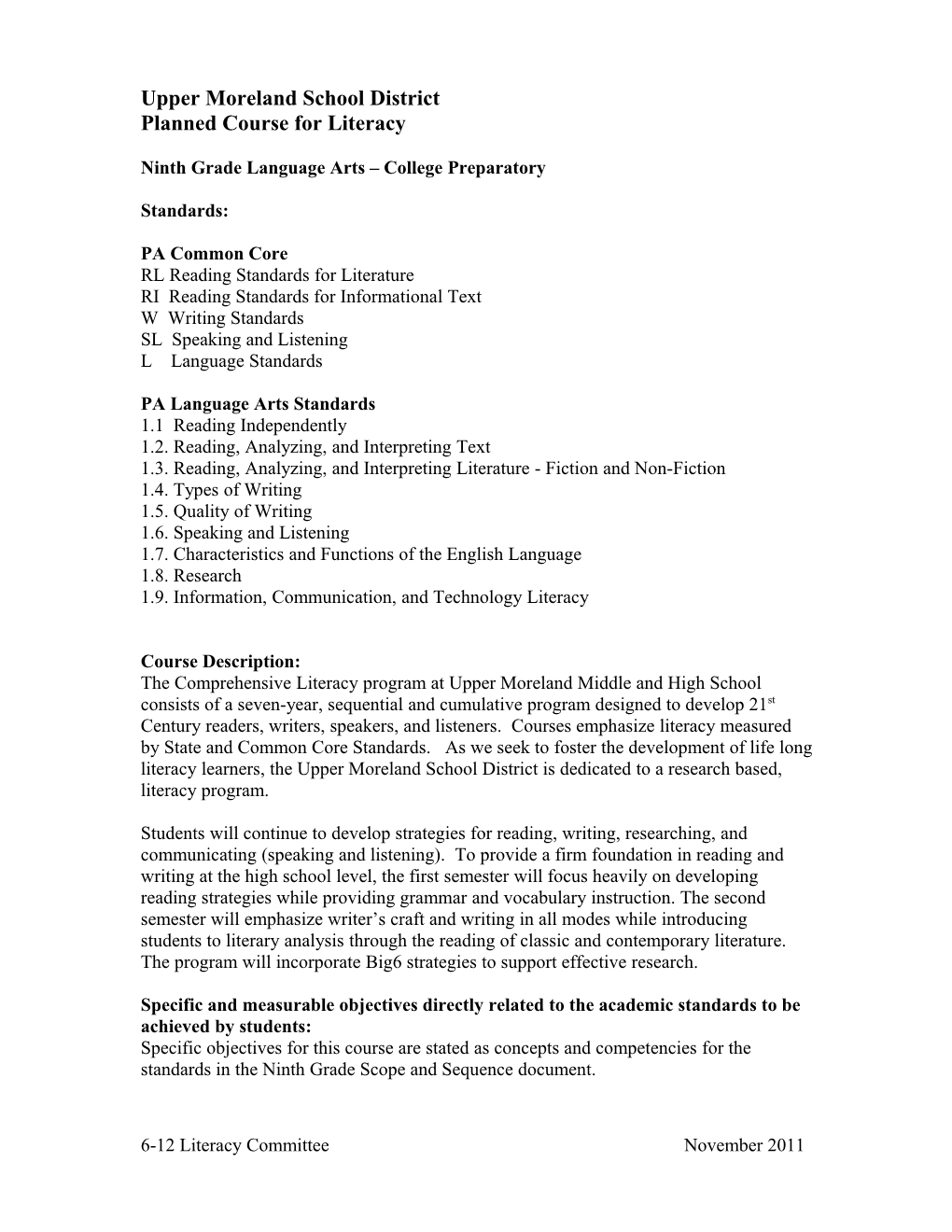UpperMorelandSchool District
Planned Course for Literacy
Ninth Grade Language Arts –College Preparatory
Standards:
PA Common Core
RL Reading Standards for Literature
RI Reading Standards for Informational Text
W Writing Standards
SL Speaking and Listening
L Language Standards
PA Language Arts Standards
1.1 Reading Independently
1.2. Reading, Analyzing, and Interpreting Text
1.3. Reading, Analyzing, and Interpreting Literature - Fiction and Non-Fiction
1.4. Types of Writing
1.5. Quality of Writing
1.6. Speaking and Listening
1.7. Characteristics and Functions of the English Language
1.8. Research
1.9. Information, Communication, and Technology Literacy
Course Description:
The Comprehensive Literacy program at Upper Moreland Middle and High School consists of a seven-year, sequential and cumulative program designed to develop 21st Century readers, writers, speakers, and listeners. Courses emphasize literacy measured by State and Common Core Standards. As we seek to foster the development of life long literacy learners, the UpperMorelandSchool District is dedicated to a research based, literacy program.
Students will continue to develop strategiesfor reading, writing, researching, and communicating (speaking and listening). To provide a firm foundation in reading and writing at the high school level, the first semester will focus heavily on developing reading strategies while providing grammar and vocabulary instruction. The second semester will emphasize writer’s craft and writing in all modes while introducing students to literary analysis through the reading of classic and contemporary literature. The program will incorporate Big6 strategies to support effective research.
Specific and measurable objectives directly related to the academic standards to be achieved by students:
Specific objectives for this course are stated as concepts and competencies for the standards in the Ninth Grade Scope and Sequence document.
Content to be used to reach objectives:
In order to offer a comprehensive 21st century literacy approach, a variety of print and electronic materials are utilized.
Materials:
Prentice Hall Literature – Gold Level (2005)
Prentice Hall Writing and Grammar (2005)
Core Curriculum Titles:
Romeo and Juliet
Lord of the Flies
To Kill a Mockingbird
The Odyssey
Animal Farm
Contemporary Young Adult Literature Titles:
Romiette and Julio
If You Come Softly
Whale Talk
Killing Mr. Griffin
People of Sparks
Shostak Vocabulary Workshop Level D
Technology
Laptops, Promethean Board, Turnitin.com, StudyIsland, Reading and Writing Software
Various supplemental materials
Instructional Activities:
A comprehensive 21st century literacy program demands use of a variety of activities to stimulate creativity and critical thinking. Below is a list of those different activities. They are defined in the glossary.
6-12 Literacy Committee November 2011
- KWL
- SQ3R
- DRA/DRTA
- Vocabulary analysis
- Reading aloud
- Thinking aloud
- Written response
- Oral discussion
- Inquiry
- Graphic organizers
- Note taking and note making
- Big 6 Inquiry Process
- Modeled Reading
- Guided Reading
- Independent Reading
- Meta-cognitive Reading Strategies
- Vocabulary Mapping
- Word Wall
- Differentiation for Reading
- Reading Workshop
6-12 Literacy Committee November 2011
Estimated instructional time to be devoted to achieving objectives:
184 days – full year (48 minutes per day)
Procedures for measurement of student progress on the objectives:
Teachers use an assortment of assessments to determine student proficiency.
They include:
6-12 Literacy Committee November 2011
- Formative and Summative Assessments
- Whole Class Discussion
- Written Response
- Oral Response
- Online discussions
- Group discussions
- Group collaboration
- Quality of writing in all modes
- Quizzes
- Tests
- Projects
- Video Projects
- Audio Projects
- Book Talks
- Read Aloud
6-12 Literacy Committee November 2011
An explanation of how student grades will be determined:
Literacy grades are determined through a variety of measures. Students are evaluated using formative and summative assessments. Formative assessments included classroom observations, teacher-student conferences and student work samples. Summative assessments are administered periodically using quizzes and unit tests, and specific mode of writing rubrics. Projects and presentations are evaluated using research based performance assessments. Grades will be determined by a variety of at least five assessments.
6-12 Literacy Committee November 2011
